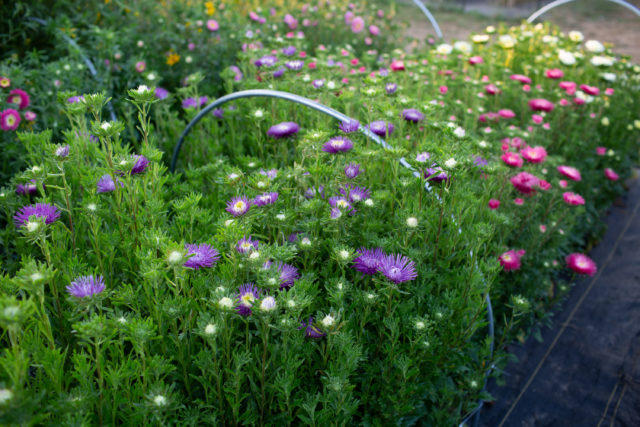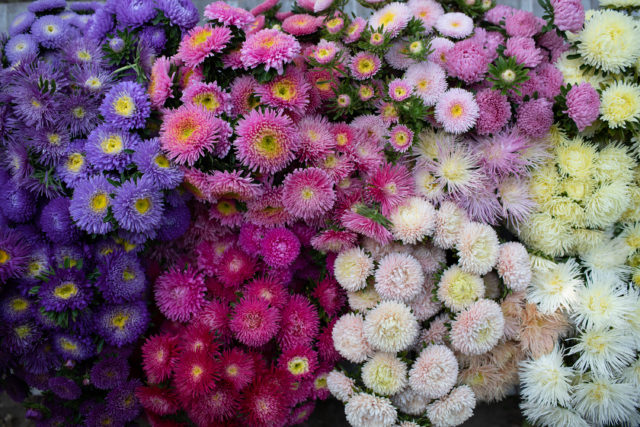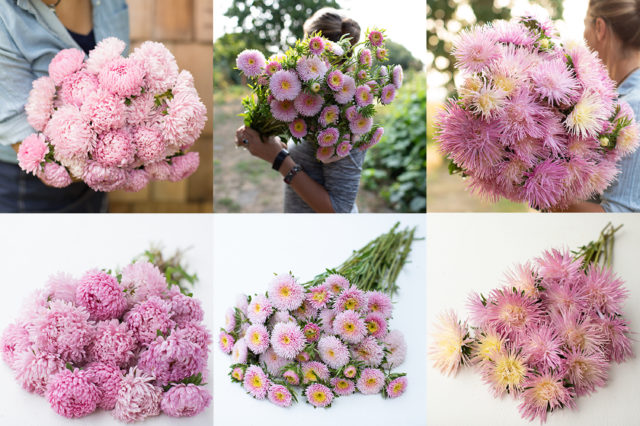For as many years as I have been growing flowers, I still can’t believe that I’ve only recently come to discover the great variety of China asters. Years ago, when we were growing for grocery store sales, the only varieties on the market were run-of-the-mill ‘Matsumoto’ and spray types. There was nothing beautiful or exciting about them, so I rarely included them in the garden. But a few years ago, I stumbled onto a German grower offering an incredible range of varieties that I had never seen before.
 The following summer we grew more than 40 varieties, and the next summer we grew 40 more, and now I am a passionate champion for China asters. What makes these plants so great is that they can be grown from seed, are easy to grow, and flower at a time when the garden is starting to fade. As the day length shortens, this group of plants is prompted to begin flowering.
The following summer we grew more than 40 varieties, and the next summer we grew 40 more, and now I am a passionate champion for China asters. What makes these plants so great is that they can be grown from seed, are easy to grow, and flower at a time when the garden is starting to fade. As the day length shortens, this group of plants is prompted to begin flowering.
In addition to lasting an incredibly long time in the vase, China asters come in a dazzling rainbow of colors and a wide range of flower shapes and sizes, including huge feathered blossoms, sturdy sprays of miniature buttons, tight domed flower heads, and soft rose-like blooms.

 China asters are typically sown 6 to 8 weeks before the last spring frost and transplanted out after the weather has sufficiently warmed. As with other cold-sensitive plants, such as zinnias, basil, and celosia, it’s important to wait to tuck these into the garden until all danger of frost has passed.
China asters are typically sown 6 to 8 weeks before the last spring frost and transplanted out after the weather has sufficiently warmed. As with other cold-sensitive plants, such as zinnias, basil, and celosia, it’s important to wait to tuck these into the garden until all danger of frost has passed.
 We grow our China asters in landscape fabric and space plants 9 inches (23 cm) apart with 5 rows per bed. Once blooms appear, plants tend to topple under the weight of the flower display, so be sure to give these guys plenty of support while the plants are still small.
We grow our China asters in landscape fabric and space plants 9 inches (23 cm) apart with 5 rows per bed. Once blooms appear, plants tend to topple under the weight of the flower display, so be sure to give these guys plenty of support while the plants are still small.

 We use a layer of Hortonova netting stretched horizontally about 12 inches (30.5 cm) above the ground. Netting is held in place by metal hoops that we made with our Johnny’s Quick Hoops Bender, but any type of stake, wooden or metal, will work just fine. As the plants grow, they push up through the grid of netting and get the support they need.
We use a layer of Hortonova netting stretched horizontally about 12 inches (30.5 cm) above the ground. Netting is held in place by metal hoops that we made with our Johnny’s Quick Hoops Bender, but any type of stake, wooden or metal, will work just fine. As the plants grow, they push up through the grid of netting and get the support they need.

 After plants are tucked into the ground, they just hang out for the better part of the summer and seem dull in the landscape. I’ve found myself fretting over them, wondering if they are going to do anything. But as summer comes to a close, they start making buds and elongating in the waning light.
After plants are tucked into the ground, they just hang out for the better part of the summer and seem dull in the landscape. I’ve found myself fretting over them, wondering if they are going to do anything. But as summer comes to a close, they start making buds and elongating in the waning light.
As the rest of the garden starts to wind down and fall apart, China asters come into their prime and, along with dahlias, help finish the flower season strong. They are a must-grow for late summer and early autumn bouquets.

 Harvest flowers when they are about halfway open, strip the foliage off the lower half of the stems, and place them into water with flower food. Expect a vase life of 7 to 10 days or even longer.
Harvest flowers when they are about halfway open, strip the foliage off the lower half of the stems, and place them into water with flower food. Expect a vase life of 7 to 10 days or even longer.
China asters are sensitive to wet weather, and the petals will brown if not harvested on time, so be sure to pick them regularly for the best-looking blooms.
 Altogether, we’ve grown close to 80 different mixes and individual varieties so I’ve had a chance to narrow down my favorites, many of them in the softer tones. Peach and blush have become extremely popular colors with floral designers and brides, so if you have wedding work in your future, you might want to consider the following varieties.
Altogether, we’ve grown close to 80 different mixes and individual varieties so I’ve had a chance to narrow down my favorites, many of them in the softer tones. Peach and blush have become extremely popular colors with floral designers and brides, so if you have wedding work in your future, you might want to consider the following varieties.
 ‘Harlekin Light Rose’: This tall, feminine beauty is smothered in an abundance of the sweetest soft, nearly ballerina-pink blooms. Disc-shaped flowers have a fluffy appearance from the hundreds of quilled, tubular petals covering them.
‘Harlekin Light Rose’: This tall, feminine beauty is smothered in an abundance of the sweetest soft, nearly ballerina-pink blooms. Disc-shaped flowers have a fluffy appearance from the hundreds of quilled, tubular petals covering them.
‘Rose Quartz Mix’: This feminine mix features warm pink tones, including dusty rose, blush, and ballet slipper pink. Delicate ruffled blooms look like pretty, soft pillows.
‘Valkyrie Pink’: The palm-sized blooms on this mauve-pink beauty remind me of the color of sea anemones. Buds are lighter than the mature flowers, giving plants a wonderful color range. Long, pointed flower petals resemble rosy cactus flowers, and as blooms are opening, the center petals are swirled.
‘Lady Coral Chamois’: With the softest peachy-blush blooms, this romantic beauty has a glowing quality. Each plant is smothered in at least a dozen stems topped with ruffled, feminine flowers.
‘Tower Chamois Apricot’: One of the most beautiful and well-loved asters, this is a must-grow. Each vigorous plant is loaded with dozens of glowing peachy-pink blooms that are perfect for flower arranging and wedding work.
‘Valkyrie Chamois’: The palm-sized blooms on this striking variety are stunning. Long, pointed flower petals resemble bird feathers, and as blooms are opening, the center petals are swirled.
 If you’re looking for some beautiful, hardworking additions to the late summer cutting garden, look no further. China asters shine when the rest of the garden starts to fade, rewarding you with a bumper crop of glowing, textural blooms.
If you’re looking for some beautiful, hardworking additions to the late summer cutting garden, look no further. China asters shine when the rest of the garden starts to fade, rewarding you with a bumper crop of glowing, textural blooms.
Do you grow China asters? Do you have a favorite variety? Please take a minute and leave a comment below about your experience growing them.
Please note: If you submit a comment and it doesn’t show up right away, sit tight; we have a spam filter that requires we approve most comments before they are published.
Lastly, if you find this information helpful, I would love it if you would share it with your friends.






Kate Kowal on
Should these plants be pinched?